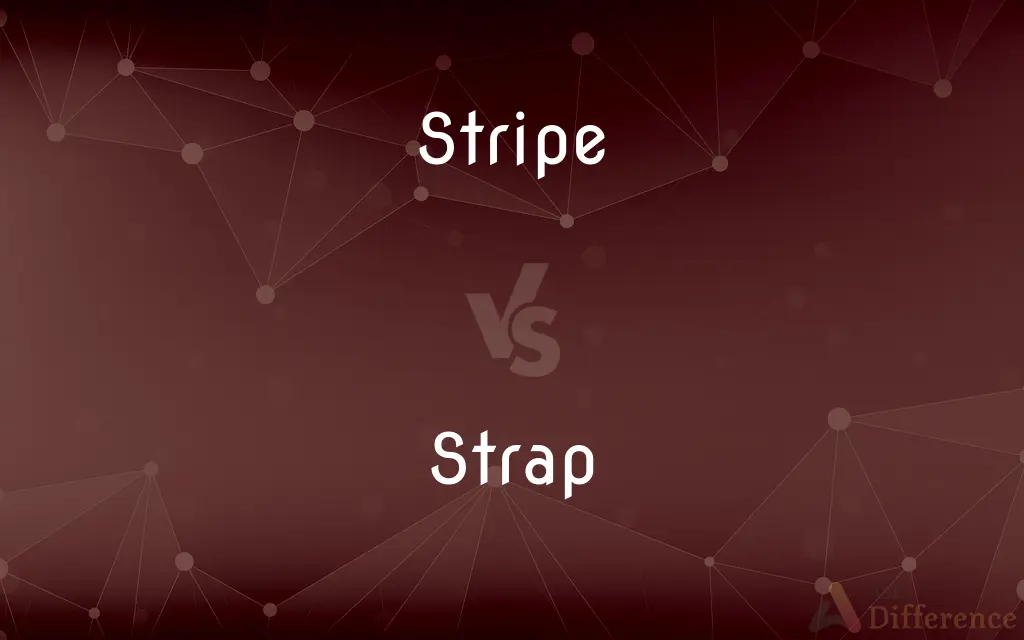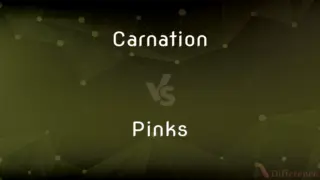Stripe vs. Strap — What's the Difference?
By Urooj Arif & Fiza Rafique — Updated on April 3, 2024
Stripe is a narrow band differing in color or texture from the surface on which it appears, while strap is a narrow strip of flexible material, often used to fasten or secure something.

Difference Between Stripe and Strap
Table of Contents
ADVERTISEMENT
Key Differences
A stripe is primarily a design or decorative element that appears as a linear band of color, texture, or material that contrasts with its surroundings. It can be found on various items, including clothing, animals, and even on roads as markings. Stripes serve as aesthetic elements or functional markers, such as those used for lane divisions on roads. On the other hand, a strap is a functional piece of material, such as leather, cloth, or plastic, designed to hold, secure, or carry objects. Straps are often part of bags, watches, shoes, and are used to secure items together or to something else, providing a practical utility.
Stripes can vary in width, color, and number, and they can be used symbolically or for visual appeal. For example, stripes on military uniforms may indicate rank or service, while stripes in fashion can influence the perception of the wearer's shape. Straps, however, are valued for their strength and flexibility. They can be adjustable, like those on a backpack for a comfortable fit, or fixed, as in the case of a handle on a suitcase, emphasizing their role in the functionality and portability of objects.
In terms of application, stripes are applied to a surface or integrated into the design of objects without altering their function. They might be painted, printed, woven, or even naturally occurring, as seen in the animal kingdom with zebras and tigers. Straps require a physical presence and are attached or made as part of an object to serve a specific purpose, such as carrying, hanging, or binding, indicating a direct interaction with the object they are part of.
The significance of stripes can extend to cultural or societal symbols, with certain patterns and colors representing affiliations, identities, or historical contexts, such as in flags, emblems, or traditional attire. Straps, while less symbolic, are essential in the design and utility of various products and equipment, highlighting their indispensable role in everyday items and specialized gear alike.
The distinction between stripe and strap extends to their respective connotations and uses. A stripe can enhance the visual appeal or convey information through its appearance, while a strap's importance lies in its utility, strength, and the support it provides, showcasing the balance between form and function in different contexts.
ADVERTISEMENT
Comparison Chart
Primary Function
Decorative or symbolic
Functional for securing or carrying
Appearance
Narrow band differing in color or texture
Narrow strip of flexible material
Application
Design element on surfaces or objects
Used to hold, secure, or carry objects
Symbolism
Can represent rank, identity, or affiliations
Less symbolic, more focused on utility
Variability
Varies in width, color, and pattern
Varies in material, length, and strength
Compare with Definitions
Stripe
Appears in the animal kingdom for camouflage or warning.
Tigers have stripes for camouflage.
Strap
Often adjustable for comfort or fit.
The helmet strap can be adjusted for a snug fit.
Stripe
A linear pattern differing in color or texture.
The shirt features bold red stripes.
Strap
Used to secure or carry objects.
He tightened the strap around the luggage.
Stripe
Can indicate rank or affiliation.
The captain's uniform has four stripes.
Strap
Part of essential equipment and gear.
The diver checked the straps on her gear before the dive.
Stripe
Influences visual perception and style.
Horizontal stripes can make a garment appear wider.
Strap
Made of leather, cloth, or plastic for flexibility and strength.
The bag's leather strap is adjustable.
Stripe
Used as lane markers on roads.
The pedestrian crossing is marked with white stripes.
Strap
Enhances the portability of items.
The camera comes with a strap for easy carrying.
Stripe
A long narrow band distinguished, as by color or texture, from the surrounding material or surface.
Strap
A strap, sometimes also called strop, is an elongated flap or ribbon, usually of leather or other flexible materials. Thin straps are used as part of clothing or baggage, or bedding such as a sleeping bag.
Stripe
A textile pattern of parallel bands or lines on a contrasting background.
Strap
A long narrow strip of pliant material such as leather.
Stripe
A fabric having such a pattern.
Strap
Such a strip equipped with a buckle or similar fastener for binding or securing objects.
Stripe
A strip of cloth or braid worn on a uniform to indicate rank, awards received, or length of service; a chevron.
Strap
A thin flat metal or plastic band used for fastening or clamping objects together or into position.
Stripe
Sort; kind
"All Fascists are not of one mind, one stripe" (Lillian Hellman).
Strap
A narrow band formed into a loop for grasping with the hand.
Stripe
A stroke or blow, as with a whip.
Strap
A razor strop.
Stripe
To mark with stripes or a stripe.
Strap
A strip of leather used in flogging.
Stripe
A long region of a single colour in a repeating pattern of similar regions.
Zebra stripes
Strap
To fasten or secure with a strap.
Stripe
A long, relatively straight region against a different coloured background.
Strap
To beat with a strap.
Stripe
(in the plural) The badge worn by certain officers in the military or other forces.
Strap
To sharpen (a razor, for example).
Stripe
(informal) Distinguishing characteristic; sign; likeness; sort.
Persons of the same political stripe
Strap
A long, narrow, pliable strip of leather, cloth, or the like.
Stripe
A long, narrow mark left by striking someone with a whip or stick; a blow with a whip or stick.
Strap
A strap worn on the shoulder.
Stripe
A slash cut into the flesh as a punishment.
Strap
A strip of thick leather used in flogging.
Stripe
(weaving) A pattern produced by arranging the warp threads in sets of alternating colours, or in sets presenting some other contrast of appearance.
Strap
Something made of such a strip, or of a part of one, or a combination of two or more for a particular use.
Stripe
Any of the balls marked with stripes in the game of pool, which one player aims to pot, the other player taking the spots.
Strap
A piece of leather, or strip of wood covered with a suitable material, used to hone the sharpened edge of a razor; a strop.
Stripe
(computing) A portion of data distributed across several separate physical disks for the sake of redundancy.
Strap
A narrow strip of anything, as of iron or brass.
Stripe
The start/finish line.
Strap
A band, plate, or loop of metal for clasping and holding timbers or parts of a machine.
Stripe
(transitive) To mark with stripes.
Strap
(nautical) A piece of rope or metal passing around a block and used for fastening it to anything.
Stripe
(transitive) To lash with a whip or strap.
Strap
(botany) The flat part of the corolla in ligulate florets, as those of the white circle in the daisy.
Stripe
To distribute data across several separate physical disks to reduce the time to read and write.
Strap
(botany) The leaf, exclusive of its sheath, in some grasses.
Stripe
A line, or long, narrow division of anything of a different color or structure from the ground; hence, any linear variation of color or structure; as, a stripe, or streak, of red on a green ground; a raised stripe.
Strap
(slang) A gun, normally a personal firearm such as a pistol or machine pistol.
Stripe
A pattern produced by arranging the warp threads in sets of alternating colors, or in sets presenting some other contrast of appearance.
Strap
Credit offered to a customer, especially for alcoholic drink.
Stripe
A strip, or long, narrow piece attached to something of a different color; as, a red or blue stripe sewed upon a garment.
Strap
(journalism) strapline
Stripe
A stroke or blow made with a whip, rod, scourge, or the like, such as usually leaves a mark.
Forty stripes he may give him, and not exceed.
Strap
A championship belt, or by extension, the title.
Stripe
A long, narrow discoloration of the skin made by the blow of a lash, rod, or the like.
Cruelty marked him with inglorious stripes.
Strap
(finance) An investment strategy involving simultaneous trade with one put and two call options on the same security at the same strike price, similar to but more bullish than a straddle.
Stripe
Color indicating a party or faction; hence, distinguishing characteristic; sign; likeness; sort; as, persons of the same political stripe.
Strap
(transitive) To beat or chastise with a strap; to whip, to lash.
Stripe
The chevron on the coat of a noncommissioned officer.
Strap
(transitive) To fasten or bind with a strap.
Stripe
To make stripes upon; to form with lines of different colors or textures; to variegate with stripes.
Strap
(transitive) To sharpen by rubbing on a strap; to strop.
To strap a razor
Stripe
To strike; to lash.
Strap
A long, narrow, pliable strip of leather, cloth, or the like; specifically, a strip of thick leather used in flogging.
A lively cobbler that . . . had scarce passed a day without giving her [his wife] the discipline of the strap.
Stripe
A strip or stripe of a contrasting color or material
Strap
Something made of such a strip, or of a part of one, or a combination of two or more for a particular use; as, a boot strap, shawl strap, stirrup strap.
Stripe
A piece of braid, usually on the sleeve, indicating military rank or length of service
Strap
A piece of leather, or strip of wood covered with a suitable material, for sharpening a razor; a strop.
Stripe
V-shaped sleeve badge indicating military rank and service;
They earned their stripes in Kuwait
Strap
A narrow strip of anything, as of iron or brass.
Stripe
A kind or category;
Businessmen of every stripe joined in opposition to the proposal
Strap
A band, plate, or loop of metal for clasping and holding timbers or parts of a machine.
Stripe
A marking of a different color or texture from the background
Strap
The flat part of the corolla in ligulate florets, as those of the white circle in the daisy.
Stripe
Mark with stripes
Strap
A piece of rope or metal passing around a block and used for fastening it to anything.
Strap
A shoulder strap. See under Shoulder.
Strap
To beat or chastise with a strap.
Strap
To fasten or bind with a strap.
Strap
To sharpen by rubbing on a strap, or strop; as, to strap a razor.
Strap
An elongated leather strip (or or strip of similar material) for binding things together or holding something in position
Strap
Hanger consisting of a loop of leather suspended from the ceiling of a bus or train; passengers hold onto it
Strap
A band that goes over the shoulder and supports a garment or bag
Strap
Whip consisting of a strip of leather used in flogging
Strap
Tie with a strap
Strap
Beat severely with a whip or rod;
The teacher often flogged the students
The children were severely trounced
Strap
Sharpen with a strap;
Strap a razor
Strap
Secure (a sprained joint) with a strap
Common Curiosities
What is the main difference between a stripe and a strap?
A stripe is a design element that adds visual appeal or conveys information, while a strap is a practical tool used for securing or carrying objects.
Do stripes appear naturally in the environment?
Yes, stripes occur naturally, especially in the animal kingdom, serving purposes like camouflage or warning.
Can stripes serve a functional purpose?
Yes, stripes can serve functional purposes, such as lane markings on roads or indicating rank in military uniforms.
Are straps only made from leather?
No, straps can be made from various materials including leather, cloth, plastic, and more, depending on their intended use.
Can the presence of a stripe change the perception of an object's size?
Yes, the direction and thickness of stripes can alter the perception of size and shape in clothing and objects.
Do stripes have cultural significance?
Stripes can have cultural significance, representing traditions, affiliations, or historical contexts in various societies.
Are straps essential in outdoor and sports equipment?
Straps are crucial in outdoor and sports equipment for securing gear and ensuring comfort and safety during activities.
Can a strap have decorative elements?
While primarily functional, straps can also feature decorative elements, especially in fashion accessories.
Is the width of a stripe important?
The width of a stripe can influence its visual impact and symbolism, making it an important aspect of its design.
Can both stripes and straps be customized?
Yes, both can be customized in terms of color, material, and design to suit specific needs or preferences.
What role do stripes play in fashion design?
In fashion design, stripes play a role in creating visual interest, altering perceptions of form, and conveying style.
How do straps contribute to safety?
Straps can contribute to safety by securing objects or equipment properly, preventing accidents or loss.
How do straps enhance the functionality of bags and luggage?
Straps enhance the functionality of bags and luggage by providing a means to securely carry or transport them.
How do stripes and straps differ in terms of utility and aesthetics?
Stripes enhance aesthetics and convey information, while straps are valued for their utility in securing and carrying objects.
Why is material choice important for straps?
The material choice for straps is important for durability, flexibility, and suitability for the strap's specific use, impacting its overall functionality.
Share Your Discovery

Previous Comparison
Carnation vs. Pinks
Next Comparison
Incautious vs. UncautiousAuthor Spotlight
Written by
Urooj ArifUrooj is a skilled content writer at Ask Difference, known for her exceptional ability to simplify complex topics into engaging and informative content. With a passion for research and a flair for clear, concise writing, she consistently delivers articles that resonate with our diverse audience.
Co-written by
Fiza RafiqueFiza Rafique is a skilled content writer at AskDifference.com, where she meticulously refines and enhances written pieces. Drawing from her vast editorial expertise, Fiza ensures clarity, accuracy, and precision in every article. Passionate about language, she continually seeks to elevate the quality of content for readers worldwide.
















































